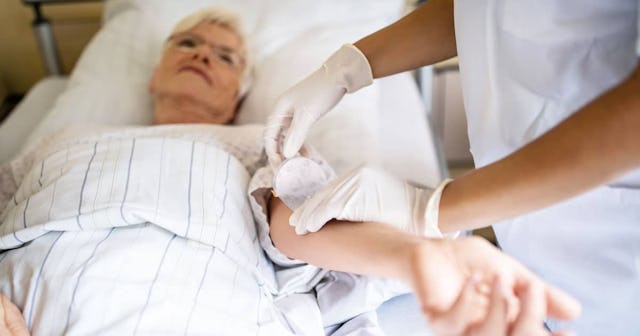We Need To Talk About The ‘In-Between’ Of COVID-19 -- It’s Not Just ‘Recovery' Or 'Death'

I’m sure we all know someone out there who doesn’t really see the point of wearing a face mask these days. Or perhaps we have a neighbor or a friend who just decided to start hitting up the beach, hanging out in a big group, or throwing caution to the wind as they finally get that non-essential haircut they’ve been jonesing for these past few months. Despite a shit ton of evidence to the contrary, it seems that many folks sincerely believe this global pandemic is officially coming to an end.
Well, I’m here to remind anyone who thinks that COVID-19 is basically over that it’s not. It’s really, really not. According to some health officials, it’s only just begun.
As of this writing, the U.S. alone has presently reached over 1.8 million cases and 106,195 deaths, and that number is still climbing. Despite certain state and local officials who have begun to re-open their economic and social doors, this pandemic is not finished with us yet. And what’s worse is that we don’t even know exactly if and when it will end.
It’s a humbling and painful truth to recognize that many of us have stories of loved ones who have died from coronavirus, while others know folks who have managed to recover. As of right now, there are survivors out there who have either not received hospital treatment due to COVID-19 symptoms deemed not viable enough to be admitted or they’ve been treated and are not recovering fully from their symptoms. And we definitely need to be talking about it. Which begs the question — what exactly happens to a person’s body in the months after surviving COVID-19? And more importantly, how does that recovery, or lack thereof, impact a survivor’s daily life as they now know it?
These are two questions that may take years to answer, but health officials are already beginning to present their theories to the public.
Here’s what we do know. Some of the patients who have recovered from COVID-19 are still experiencing fatigue, body pain, and the inability to breathe properly months after they were infected. And this is just the tip of the iceberg for the long-term medical issues impacting survivors. New studies are being conducted on a small scale in Hong Kong and Wuhan, China that provide further evidence of those recovering who are now experiencing a breakdown in their lung, heart, and liver functions. Since COVID-19 sometimes forces a person’s immune system to go absolutely haywire as it attempts to fight off the virus, other parts of the body are becoming inevitably compromised in the process.
“COVID-19 isn’t just ‘you get better’ or ‘you die,’” writes retired Navy officer Sherri Santos in a tweet on May 24th. “My sister is in week eight. Four weeks of high fever, extreme body aches, and crushing fatigue… in week eight, her oxygen saturation drops to abnormal levels if she climbs a flight of stairs. Any exertion, a short walk or drive, still results in her needing hours of recovery… She is my best friend, and at least three times, I thought I was going to lose her.”
Medioimages/Photodisc/Getty
The medical community does not yet know how long these physical effects will be impacting survivors. But it has been a long enough time to acknowledge what we all have likely feared – that this pandemic is insidious, relentless, and terrifyingly mysterious. Since there are so many unknown variables at play here, researchers have taken to investigating past widespread viruses to better prepare the public for what may be yet to come.
“While researchers are only starting to track the long-term health of survivors, past epidemics caused by similar viruses show that the aftermath can last more than a decade,” writes Lisa Du in a May 12th article for Bloomberg. “According to one study, survivors of severe acute respiratory syndrome, or SARS, suffered lung infections, higher cholesterol levels and were falling sick more frequently than others for as long as 12 years after the epidemic coursed through Asia, killing almost 800 people.”
The physical debilitation of this pandemic is only one aspect of suffering for survivors and the public at large. According to data recently released by the Census Bureau, a third of Americans are also experiencing symptoms of clinical anxiety and depression, most likely due to overwhelming job losses, housing struggles, financial burdens, and extreme modifications of education and healthcare. We’re also just beginning to grapple with the devastating reality that even after a vaccine arrives, COVID-19 will likely continue to be a part of our human experience potentially for decades more and become what medical experts and scientists deem an “endemic,” on par with diseases like measles and HIV.
Which makes the collectively rushed desire to re-open America’s economy pretty damn reckless, don’t you think?
“It’s like we have attention-deficit disorder right now,” former CDC director Tom Frieden told The Washington Post on May 27th. “Everything we’re doing is just a knee-jerk response to the short-term. People keep asking me, ‘What’s the one thing we have to do?’ The one thing we have to do is to understand that there is not one thing. We need a comprehensive battle strategy, meticulously implemented.”
In order for the vast majority of us to survive and even one day thrive again, we are going to need to slow our roll, wear a goddamn mask, and stay home whenever possible. I’d also love to throw into the mix a little request. It would be so totally awesome if our president would finally start responding to this catastrophic crisis with the vigilance, empathy, and mindful leadership it deserves. But I know that’s a tall order to ask of him. He’s too busy playing golf and spreading animosity via Twitter.
This article was originally published on